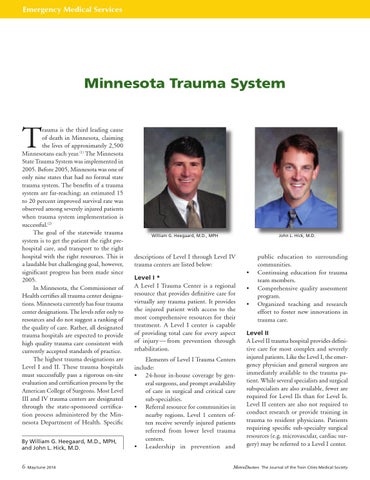Emergency Medical Care Medical Organizations Services
Minnesota Trauma System
T
rauma is the third leading cause of death in Minnesota, claiming the lives of approximately 2,500 Minnesotans each year.(1) The Minnesota State Trauma System was implemented in 2005. Before 2005, Minnesota was one of only nine states that had no formal state trauma system. The benefits of a trauma system are far-reaching; an estimated 15 to 20 percent improved survival rate was observed among severely injured patients when trauma system implementation is successful.(2) The goal of the statewide trauma system is to get the patient the right prehospital care, and transport to the right hospital with the right resources. This is a laudable but challenging goal, however, significant progress has been made since 2005. In Minnesota, the Commissioner of Health certifies all trauma center designations. Minnesota currently has four trauma center designations. The levels refer only to resources and do not suggest a ranking of the quality of care. Rather, all designated trauma hospitals are expected to provide high quality trauma care consistent with currently accepted standards of practice. The highest trauma designations are Level I and II. These trauma hospitals must successfully pass a rigorous on-site evaluation and certification process by the American College of Surgeons. Most Level III and IV trauma centers are designated through the state-sponsored certification process administered by the Minnesota Department of Health. Specific By William G. Heegaard, M.D., MPH, and John L. Hick, M.D.
6
May/June 2014
William G. Heegaard, M.D., MPH
John L. Hick, M.D.
descriptions of Level I through Level IV trauma centers are listed below: •
Level I *
A Level I Trauma Center is a regional resource that provides definitive care for virtually any trauma patient. It provides the injured patient with access to the most comprehensive resources for their treatment. A Level I center is capable of providing total care for every aspect of injury — from prevention through rehabilitation. Elements of Level I Trauma Centers include: • 24-hour in-house coverage by general surgeons, and prompt availability of care in surgical and critical care sub-specialties. • Referral resource for communities in nearby regions. Level 1 centers often receive severely injured patients referred from lower level trauma centers. • Leadership in prevention and
• •
public education to surrounding communities. Continuing education for trauma team members. Comprehensive quality assessment program. Organized teaching and research effort to foster new innovations in trauma care.
Level II
A Level II trauma hospital provides definitive care for most complex and severely injured patients. Like the Level I, the emergency physician and general surgeon are immediately available to the trauma patient. While several specialists and surgical subspecialists are also available, fewer are required for Level IIs than for Level Is. Level II centers are also not required to conduct research or provide training in trauma to resident physicians. Patients requiring specific sub-specialty surgical resources (e.g. microvascular, cardiac surgery) may be referred to a Level I center.
MetroDoctors
The Journal of the Twin Cities Medical Society
